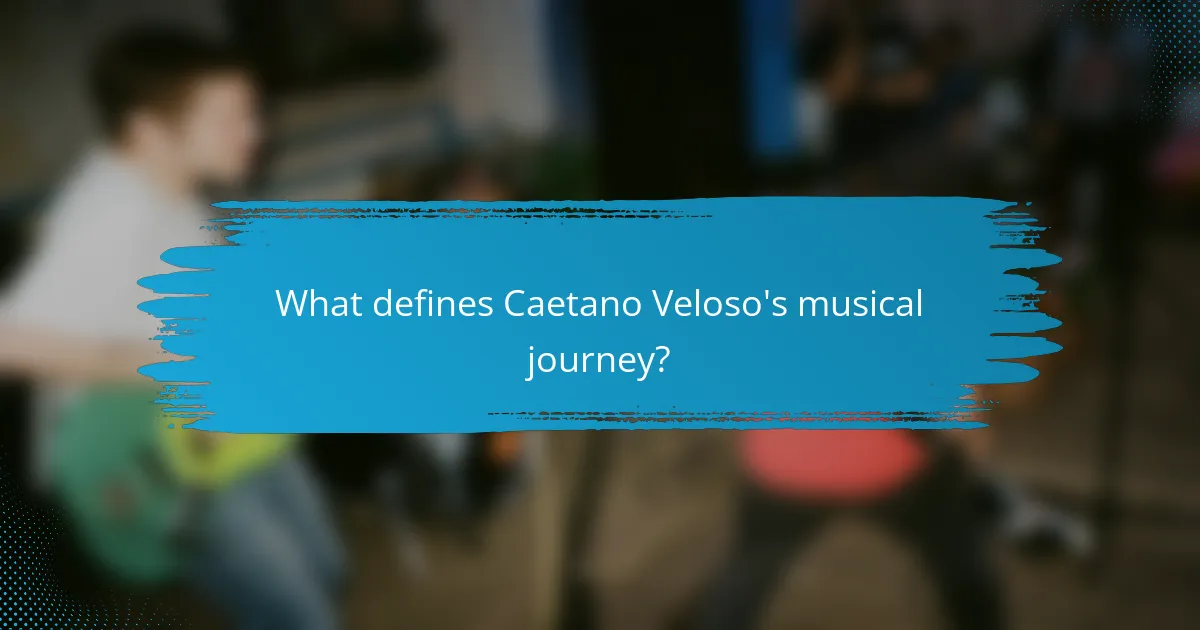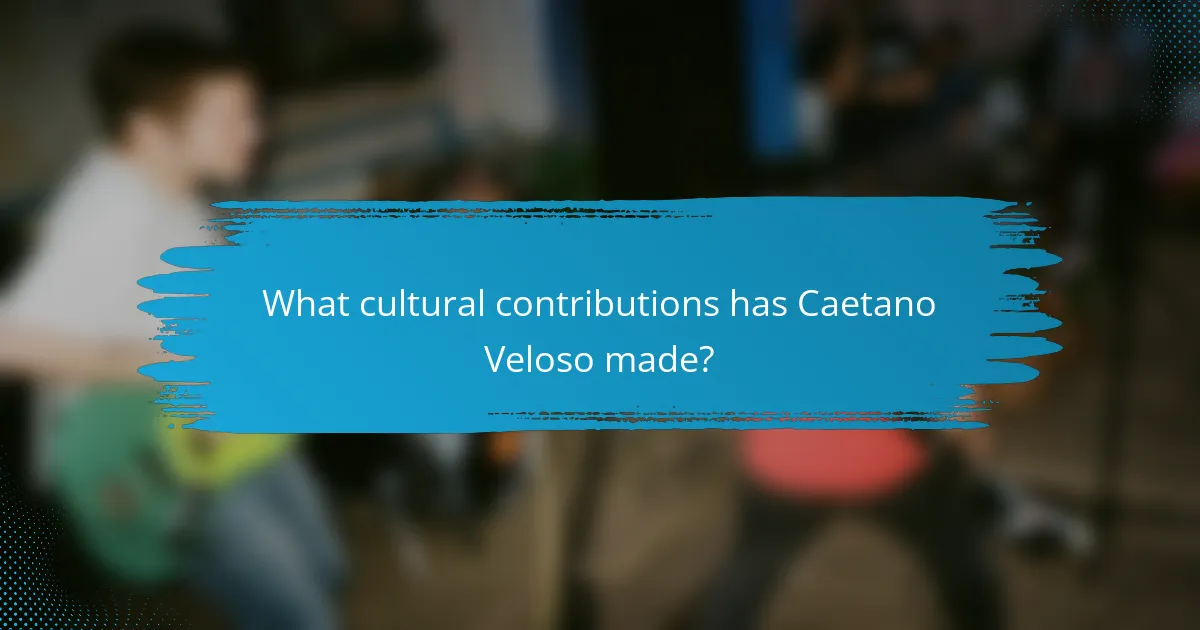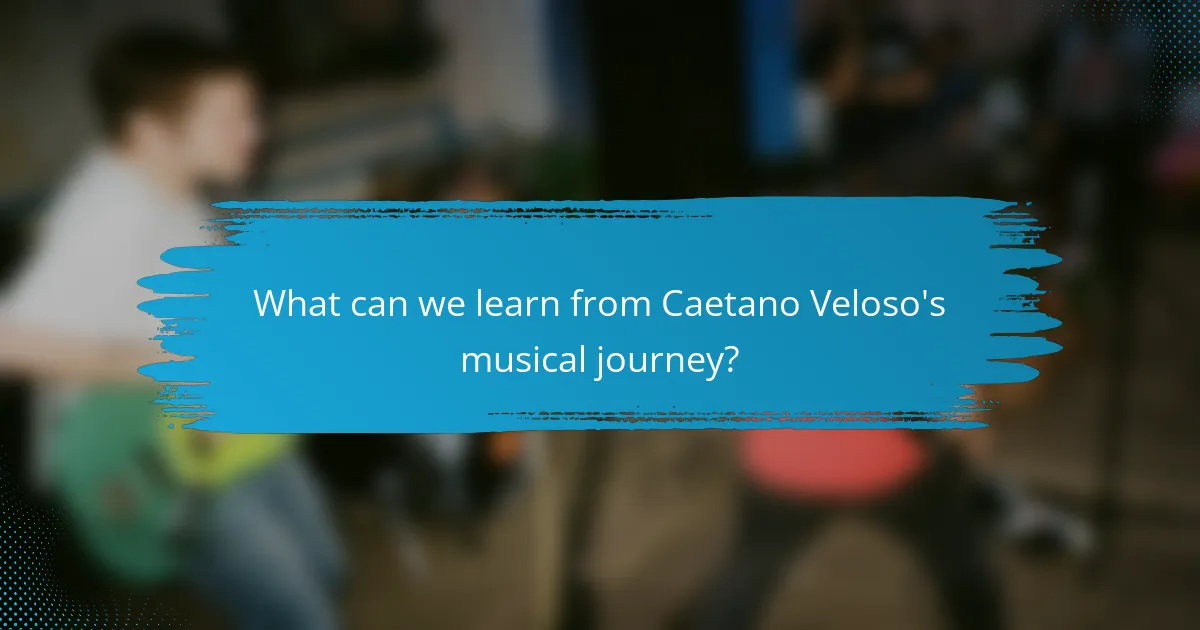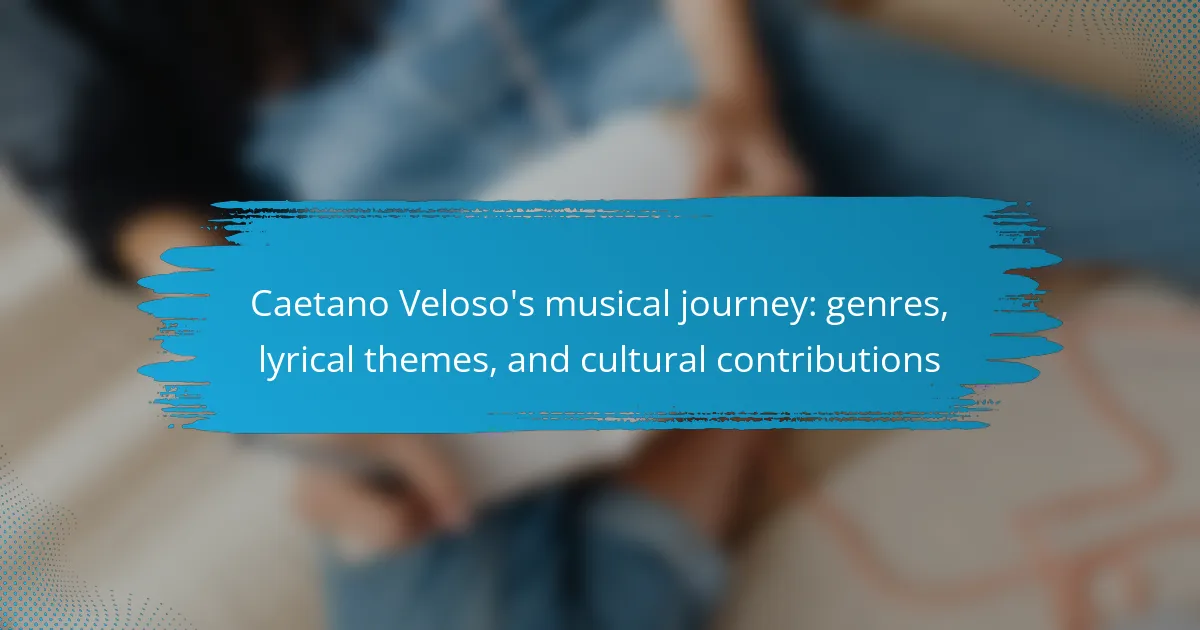Caetano Veloso is a prominent Brazilian musician known for his innovative fusion of traditional Brazilian music with international genres, particularly rock and pop. As a key figure in the Tropicália movement of the 1960s, he has profoundly influenced the cultural landscape of Brazil through his socially and politically charged lyrics. Veloso’s extensive discography includes over 30 albums and has earned him multiple awards, including Latin Grammy Awards. His artistic contributions extend beyond music to theater and literature, showcasing his versatility and impact on contemporary Brazilian culture. This article explores Veloso’s musical journey, highlighting his genre-blending style, lyrical themes, and significant cultural contributions.

What defines Caetano Veloso’s musical journey?
Caetano Veloso’s musical journey is defined by his innovative blend of genres and profound lyrical themes. He is a key figure in the Tropicália movement, which emerged in the 1960s in Brazil. This movement fused traditional Brazilian music with international influences like rock and pop. Veloso’s lyrics often explore social and political issues, reflecting Brazil’s cultural landscape. His work has earned him numerous awards, including multiple Latin Grammy Awards. Veloso has released over 30 albums, showcasing his versatility as an artist. His contributions have significantly shaped Brazilian music and inspired generations of musicians.
How did Caetano Veloso’s early life influence his music?
Caetano Veloso’s early life significantly influenced his music. He was born in 1942 in Santo Amaro, Bahia, Brazil. Growing up in a culturally rich environment, he was exposed to various musical styles. His family’s appreciation for music played a crucial role in his development. Veloso was influenced by traditional Brazilian music, particularly samba and bossa nova. He also encountered international artists, which shaped his eclectic style. The political climate in Brazil during his youth affected his lyrical themes. His experiences with censorship and exile inspired his activism and songwriting. These foundational elements are evident in his diverse musical repertoire.
What cultural and social factors shaped his upbringing?
Caetano Veloso’s upbringing was shaped by the cultural and social environment of Brazil in the mid-20th century. He grew up in a diverse and vibrant cultural setting in Bahia. The region is known for its rich Afro-Brazilian heritage, which influenced his musical style. Veloso’s family was musically inclined, fostering his early interest in music. The political climate during his youth, particularly the military dictatorship, also impacted his artistic expression. His exposure to various musical genres, including bossa nova and tropicalia, informed his creative development. Additionally, the social movements of the time encouraged a fusion of traditional and contemporary influences. These factors collectively contributed to his unique artistic identity and musical journey.
How did his education contribute to his musical development?
Caetano Veloso’s education significantly shaped his musical development. He studied at the Federal University of Bahia, where he immersed himself in various musical genres. This academic environment exposed him to Brazilian music, classical music, and international influences. His exposure to diverse musical styles enriched his songwriting and performance techniques. Furthermore, his education fostered critical thinking and creativity. This intellectual foundation allowed him to innovate within the Tropicália movement. His academic background contributed to his ability to blend traditional Brazilian sounds with contemporary music. Overall, his education was instrumental in shaping his artistic identity and musical contributions.
What genres has Caetano Veloso explored throughout his career?
Caetano Veloso has explored a wide range of musical genres throughout his career. His work encompasses Brazilian popular music, Tropicália, bossa nova, samba, rock, and MPB (Música Popular Brasileira). Veloso’s style is characterized by its fusion of traditional Brazilian sounds with international influences. He has incorporated elements of folk, jazz, and even classical music into his compositions. Over the decades, his genre experimentation has played a significant role in shaping modern Brazilian music. Notably, Veloso’s album “Tropicália: ou Panis et Circenses” is a landmark in the Tropicália movement, blending various styles and challenging musical norms. His versatility continues to influence artists across different genres today.
How did Tropicalia impact his musical style?
Tropicalia significantly transformed Caetano Veloso’s musical style. It introduced a fusion of Brazilian music with international influences. This movement embraced rock, avant-garde, and traditional Brazilian genres. Veloso incorporated these diverse sounds into his work, creating a unique blend. The use of unconventional instruments and arrangements became a hallmark of his music. Tropicalia also emphasized lyrical experimentation, often addressing political and social issues. This shift in lyrical focus reflected the cultural climate of Brazil during the late 1960s. Veloso’s participation in Tropicalia solidified his role as a leading figure in Brazilian music.
What are the key characteristics of his bossa nova influences?
Caetano Veloso’s bossa nova influences are characterized by smooth melodies and sophisticated harmonies. His music often features syncopated rhythms that create a laid-back feel. Veloso incorporates jazz elements, which enhance the harmonic complexity. He uses poetic lyrics that reflect both personal and social themes. The instrumentation typically includes soft guitar and gentle percussion. His vocal style is intimate and expressive, conveying deep emotion. These characteristics align with the original bossa nova movement, which emerged in the late 1950s in Brazil. Veloso’s approach has helped to modernize and globalize the genre.
In what ways has he incorporated world music into his repertoire?
Caetano Veloso has incorporated world music into his repertoire through diverse musical styles and collaborations. He blends traditional Brazilian music with elements from African, Caribbean, and European genres. Veloso has collaborated with international artists, enhancing his global sound. He often uses varied instruments from different cultures in his compositions. His albums feature rhythms and melodies inspired by various world music traditions. Veloso’s lyrics reflect themes and stories drawn from global influences. He has performed at international festivals, showcasing his fusion of styles. His work exemplifies a commitment to cultural exchange and innovation in music.
What are the lyrical themes prevalent in Caetano Veloso’s work?
Caetano Veloso’s work features lyrical themes of love, identity, and social commentary. His songs often explore personal relationships and emotional depth. Veloso addresses cultural identity, reflecting Brazil’s diverse heritage. Political themes are prevalent, critiquing social injustices and government policies. Nature and [censured] also appear in his lyrics, connecting personal experiences to broader existential questions. His music often blends traditional Brazilian sounds with global influences, enriching his thematic exploration. Veloso’s ability to weave these themes into his work has made a significant impact on Brazilian music and culture.
How does he address political issues in his lyrics?
Caetano Veloso addresses political issues in his lyrics through direct commentary and metaphorical language. He often critiques social injustices and governmental policies. His song “Coração Vagabundo” reflects on freedom and the struggles against oppression. Veloso uses personal narratives to connect broader political themes to individual experiences. He also incorporates historical references to Brazilian politics, such as the military dictatorship. His work during the Tropicália movement challenged cultural norms and promoted political awareness. Veloso’s lyrics encourage listeners to engage with social issues critically. His artistic expressions have had a lasting impact on Brazilian music and political discourse.
What role does love and personal experience play in his songwriting?
Love and personal experience are central to Caetano Veloso’s songwriting. His lyrics often reflect deep emotional connections and personal narratives. Veloso draws inspiration from his relationships and life events. This creates authenticity in his music. For example, his song “Sozinho” conveys feelings of loneliness and longing. His use of personal anecdotes makes his work relatable. Veloso’s experiences shape his themes, blending love with cultural and social commentary. This connection to personal experience enriches his artistic expression.
How does his work reflect Brazilian culture and identity?
Caetano Veloso’s work reflects Brazilian culture and identity through its fusion of diverse musical genres. He blends traditional Brazilian sounds with international influences, showcasing the country’s rich musical heritage. His lyrics often address social and political issues relevant to Brazil, emphasizing themes of identity, freedom, and resistance. Veloso’s incorporation of regional rhythms highlights the cultural diversity within Brazil. He also draws inspiration from Brazilian literature and poetry, enriching his music with local narratives. His participation in the Tropicalia movement further emphasizes the avant-garde nature of Brazilian culture. Overall, Veloso’s artistry serves as a mirror to Brazil’s complex societal landscape and cultural evolution.

What cultural contributions has Caetano Veloso made?
Caetano Veloso has made significant cultural contributions through his music and activism. He is a key figure in the Tropicália movement, which blended traditional Brazilian music with international influences. Veloso’s lyrics often address social and political issues, reflecting Brazil’s cultural landscape. His work has inspired generations of musicians in Brazil and beyond. He has received numerous awards, including the Latin Grammy for Best Brazilian Music Album. Veloso’s influence extends to theater and literature, where his artistic expression has shaped contemporary Brazilian culture. His collaboration with various artists has further enriched the cultural scene. Overall, Veloso’s impact is profound and multifaceted, making him a cultural icon.
How has he influenced Brazilian music and artists?
Caetano Veloso has significantly influenced Brazilian music and artists through his innovative fusion of genres. He is known for blending traditional Brazilian sounds with international styles such as rock and jazz. This genre fusion has inspired countless musicians in Brazil and beyond. Veloso’s lyrical themes often explore social and political issues, encouraging other artists to address similar topics in their work. His contributions to the Tropicália movement in the 1960s challenged cultural norms and reshaped Brazilian music. Veloso’s collaborations with various artists have further expanded his influence. His ability to adapt and evolve musically has set a precedent for future generations. Overall, his work has left a lasting impact on the Brazilian music landscape.
Which contemporary artists cite him as an inspiration?
Contemporary artists such as David Byrne, Beck, and Devendra Banhart cite Caetano Veloso as an inspiration. David Byrne has expressed admiration for Veloso’s innovative blend of genres. Beck has acknowledged Veloso’s influence on his eclectic musical style. Devendra Banhart often references Veloso’s work in interviews, highlighting its impact on his own artistic development. These artists reflect Veloso’s significance in contemporary music through their acknowledgment of his contributions.
What legacy has he left in the Brazilian music scene?
Caetano Veloso has left a profound legacy in the Brazilian music scene. He is a pioneer of the Tropicália movement, which blended traditional Brazilian music with international influences. His innovative approach has inspired countless artists across various genres. Veloso’s lyrics often address social and political issues, reflecting Brazil’s cultural landscape. He has received numerous awards, including Grammy accolades, underscoring his impact. His work has contributed to the global recognition of Brazilian music. Veloso’s influence extends beyond music into literature and activism, shaping cultural discourse in Brazil. His collaborations with diverse musicians have further enriched the Brazilian music scene.
What role has Veloso played in promoting Brazilian culture globally?
Caetano Veloso has played a significant role in promoting Brazilian culture globally. His music blends traditional Brazilian styles with international influences. Veloso’s work has introduced audiences worldwide to genres like MPB, samba, and bossa nova. He has collaborated with various international artists, enhancing cross-cultural exchange. His lyrics often reflect Brazilian social issues, art, and history. Veloso’s performances at global festivals have showcased Brazilian music to diverse audiences. His albums have received international acclaim, further increasing the visibility of Brazilian culture. Overall, Veloso’s contributions have helped position Brazil as a vibrant cultural force on the world stage.
How has his music been received in international markets?
Caetano Veloso’s music has been well received in international markets. His albums have achieved critical acclaim and commercial success globally. For instance, his album “Transa” is considered a landmark in Brazilian music and has influenced numerous artists worldwide. Veloso’s blend of tropicalia, MPB, and other genres resonates with diverse audiences. He has toured extensively, performing in major cities across Europe, North America, and Asia. His ability to communicate through both Portuguese and English has broadened his appeal. Awards such as the Grammy Award for Best World Music Album further validate his international recognition. Overall, Veloso’s innovative sound and lyrical depth have established him as a significant figure in global music.
What collaborations has he undertaken to bridge cultures?
Caetano Veloso has collaborated with various artists to bridge cultures. He worked with Gilberto Gil on the Tropicalia movement, blending Brazilian music with international influences. This collaboration introduced rock and avant-garde elements into traditional Brazilian music. Veloso also partnered with artists like David Byrne and Jorge Drexler, creating cross-cultural musical exchanges. His work with international musicians showcases the fusion of diverse musical styles. These collaborations have fostered cultural dialogue and understanding through music. Veloso’s contributions have significantly impacted the global perception of Brazilian music.

What can we learn from Caetano Veloso’s musical journey?
Caetano Veloso’s musical journey teaches us the importance of cultural fusion in music. He blends traditional Brazilian sounds with international genres like rock and pop. This approach has broadened the appeal of Brazilian music globally. Veloso’s lyrics often address social and political issues, reflecting the complexities of Brazilian society. His work emphasizes the role of art in activism. Veloso’s career demonstrates resilience in the face of censorship and political oppression. He has navigated various musical styles, showcasing versatility and innovation. Overall, his journey highlights the transformative power of music in cultural identity and expression.
What best practices can emerging artists draw from his career?
Emerging artists can draw several best practices from Caetano Veloso’s career. First, they should embrace diverse musical influences. Veloso blends genres like MPB, rock, and samba. This versatility allows for creativity and broader appeal. Second, artists must focus on strong lyrical content. Veloso’s lyrics often reflect social and political themes. This connection to culture resonates with audiences. Third, maintaining authenticity is crucial. Veloso remains true to his roots while innovating. Lastly, building a strong personal brand is essential. Veloso’s unique image and storytelling attract loyal followers. These practices can guide emerging artists in their own careers.
How can artists balance commercial success with artistic integrity?
Artists can balance commercial success with artistic integrity by staying true to their unique voice while adapting to market demands. They should prioritize their core values and creative vision. This allows them to produce authentic work that resonates with their audience. At the same time, they can explore popular trends without compromising their artistic essence. Engaging with fans can provide insights into what resonates commercially. Successful artists often maintain a clear brand identity that reflects their artistic principles. For instance, Caetano Veloso has navigated commercial success while preserving his distinct musical style and cultural messages. This balance can lead to a sustainable career that honors both artistic integrity and market viability.
What strategies can musicians use to stay relevant in changing musical landscapes?
Musicians can stay relevant in changing musical landscapes by embracing innovation and collaboration. They should explore new genres and styles to diversify their sound. Engaging with emerging technologies, like social media and streaming platforms, enhances outreach. Collaborating with other artists can introduce fresh perspectives and broaden their audience. Staying informed about industry trends allows musicians to adapt their strategies effectively. Regularly releasing new content keeps their presence active in listeners’ minds. Participating in live performances and virtual events fosters a connection with fans. Lastly, addressing current social issues in their music resonates with audiences and maintains cultural relevance.
Caetano Veloso is a prominent Brazilian musician known for his innovative blend of genres and profound lyrical themes. His musical journey is deeply intertwined with the Tropicália movement, which fused traditional Brazilian music with international influences. The article explores Veloso’s early life, educational background, and the cultural and social factors that shaped his artistry, highlighting his contributions to various genres, including MPB, bossa nova, and rock. It also examines the recurring lyrical themes in his work, such as love, identity, and political commentary, while detailing his significant cultural contributions and lasting influence on Brazilian music and artists.
